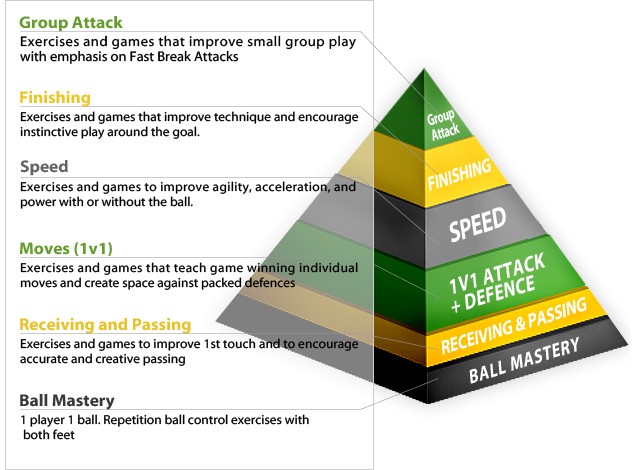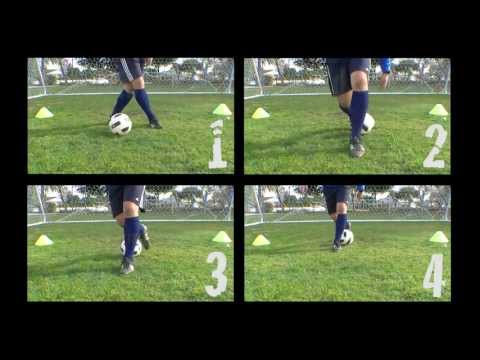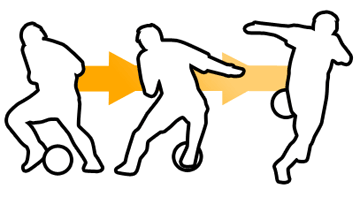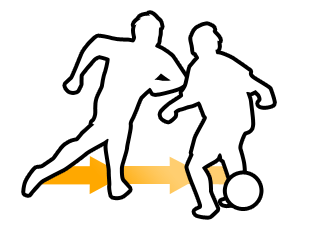Today, when the term “talent” is still primarily spread through word of mouth, developments in coaching have made it easier for young people to emulate the greats. Coaching has become increasingly important at both amateur and professional levels, with some even turning to hypnosis in an attempt to enhance their skills on the field. Sports psychologists are also employed by clubs to assist players in reaching stardom.

One pivotal moment was the emergence of the Coerver coaching method in the 1970s, pioneered by Dutchman Wiel Coerver, a former manager of Feyenoord. Coerver argued that by studying footage of exceptional players in action, one could deconstruct their trademark techniques and utilize this knowledge to train young players. The fundamental principles of this learning approach are still implemented in today’s training, and some techniques are now commonly referred to as Coerver moves.
The depth and intricacy of football coaching is such that a mere set of guidelines would fall short. Nevertheless, there are some notable maneuvers worth mentioning, particularly those associated with the soccer:
Coerver Moves
- Step Ups: Alternate between feet, making sure the bottom of each foot touches the top of the ball.
- Forward and Backward Step Ups: Perform the same alternating foot step ups as described above, but this time, move the ball forward for five steps and then backward for five steps. Ideally, repeat this sequence.
- Pendulums or Foundations: Transfer the ball from the right foot to the left foot using the inside of both feet.
- SI (Sole Inside): Pull the ball back with the bottom of the foot, then strike it forward with the top of the foot. Switch feet and repeat the sequence.
- SII (Sole Inside Inside): Pull the ball back with the bottom of the foot, then strike it forward with the inside of the foot. Switch feet and repeat the sequence.
- Outside Inside Roll: Start by placing your right foot on top of the ball and rolling it towards the outside of the ball. Then, use the inside of the right foot to push the ball towards the left foot. Repeat the same action by placing the bottom of the left foot on top of the ball.
- Roll 1-2: Begin with the ball positioned to the right side of your body. Roll the ball towards the left side of your body using the inside of the right foot. Follow it up with a two-touch pendulum, starting with the left foot. Next, roll the ball with the inside of the left foot towards the right side of your body. Complete another two-touch pendulum, this time starting with the right foot. Repeat this sequence.
- Step over 1-2-3: Place the ball in front of your right foot. Perform a circular motion by swinging your right foot and leg around the ball from the left side to the right side without touching the ball (step over). Then, execute a three-touch pendulum, starting with the right foot (right, left, right). The ball should end up in front of your left foot. Swing your left foot and leg around the ball, starting from the right side to the left side. Complete a three-touch pendulum, this time starting with the left foot (left, right, left). The ball should be in front of your right foot. Repeat this sequence.
- Weaver Push: Position the ball in front of your feet. Swing your right foot and leg around the ball, moving from the right side to the left side. The outside of your right foot should be next to the ball. Strike the ball towards the right side of your body using the outside of the right foot. Shift your body towards the ball and perform a three-touch pendulum, starting with the right foot. The ball should be in front of your body again. Step over the ball with your left foot and leg, moving from the left side to the right side of the ball. Hit the ball towards the left side with the outside of the left foot. Complete a three-touch pendulum, starting with the left foot. Repeat this sequence.
- L and Backwards L: Place the ball in front of your right foot. Pull the ball back with the bottom of your right foot and, in a continuous motion, rotate your hip and foot towards the right. Strike the ball to the right using the inside of your right foot, creating an L-shaped movement. Next, place your left foot on the ball, pull it back, and in a continuous motion, rotate your hip and foot. Then, hit the ball forward with the inside of your left foot, causing the ball to move in a backwards L direction. Repeat this sequence.
- L and Backwards L with the outside of the foot: Perform the same L and Backwards L move described above, but instead of hitting the ball with the inside of the foot after the turn, use the outside of your foot. Pull the ball back with the bottom of your foot, then strike it with the outside of your foot, directing it away from your body into open space.
- Fancy L: Similar to the L move, but with a variation. After pulling the ball back with the bottom of your right foot, hit the ball with the inside of your right foot behind your plant foot, into the open space. This move requires two touches: one to pull the ball back and another to hit the ball to the side. Repeat this sequence.
- Pull back: Place the ball in front of your right foot. Pull the ball back with the bottom of your right foot, then strike it behind your left foot and leg using the inside of your right foot, creating a backward L movement. The ball should end up on the left side of your body. Pull the ball back with your left foot and hit it behind your right leg and foot with the inside of your left foot, creating an L movement. Repeat this sequence.
- Triangle: Position the ball in front of your right foot. Pull the ball back with the bottom of your right foot, then perform a two-touch pendulum, starting with the right foot (right, left). With your right foot, strike the ball diagonally forward in front of your left foot. Pull the ball back with the bottom of your left foot, then execute a two-touch pendulum, starting with the left foot (left, right). Finally, hit the ball diagonally forward in front of your right foot with your left foot. Repeat this sequence.
- Step over outside: Place the ball in front of your right foot. Step over the ball in a circular motion, moving from the left side of the ball towards the right side with your right foot. Then, strike the ball towards the left side of your body with the outside of your left foot. Perform a two-touch pendulum, starting with the left foot. Step over the ball with your left foot, beginning on the right side of the ball, then hit the ball towards the right side of your body with the outside of your right foot. Complete a two-touch pendulum, starting with the right foot. Repeat this sequence.
- Pull back touch: Pull the ball back with your right foot, then touch the ball forward with the outside of your left foot. Pull the ball back with your left foot, then touch it forward with the outside of your right foot. Repeat this sequence.
- SIII (Sole Inside Outside Inside): Pull the ball back with the bottom of your foot, then strike it forward with the outside of your foot. Switch feet and repeat the same sequence.
Change of direction moves
- Inside cut: While dribbling in any direction, place the inside of your foot on the far side of the ball and change direction at a 90-degree angle.
- Outside cut: While dribbling in any direction, place the outside of your foot on the far side of the ball and change direction at a 90-degree angle.
- Step Back: While dribbling in any direction, step on the ball with your right foot and then push the ball in the opposite direction using the outside of your left foot. Alternatively, you can switch the order of feet.
- Weaver: While dribbling in any direction, perform a step-over motion with your right foot and leg, moving in a circular motion over the ball. After stepping over the ball with your right foot, plant your right foot next to the left side of the ball. Then, turn your body and dribble the ball in the new direction with the inside of your left foot. Alternatively, you can switch the order of feet.
- Pull Back: While dribbling in any direction, plant your left foot next to the ball. Reach your right foot around to the far side of the ball and pull the ball back behind your body using the inside of your right foot. Then, push the ball away from your body with the outside of your left foot. Alternatively, you can switch the order of the feet.
Attacking Moves
Head and Shoulders Fake: While dribbling forwards, lunge towards the right side of the ball with your right foot, leg, head, and shoulders. Then, dribble the ball at a 45-degree angle away from your body using the outside of your left foot. Alternatively, you can switch the order with your feet.
Step Over Head and Shoulders Fake (Half Scissors): While dribbling forwards, step over the ball with your right foot from the left side to the right side of the ball. Plant your foot with your head and shoulders facing the right next to the right side of the ball. Then, push the ball at a 45-degree angle away from your body using the outside of your left foot. Alternatively, you can switch the order.
Stop and Go #1: While dribbling forwards, fake an inside cut with the inside of your right foot and drag your left foot forward to dribble the ball forward with the inside of your left foot. Make sure to turn your right hip during the inside cut to deceive the defender into thinking you’re changing directions. Alternatively, you can switch the order with your feet.
Stop and Go #2: While dribbling forwards, fake a step back with your right foot and drag your left foot forward to dribble the ball forward with the inside of your left foot. Dribble forward, step on top of the ball with your right foot, then drag your left foot forward and continue dribbling forward with the inside of your left foot. Alternatively, you can switch the order with your feet.
Stop and Go #3: While dribbling forwards, step on top of the ball with your right foot and then push the ball forward with the top of your right foot. Alternatively, you can switch the order of the feet.
Stutter: While dribbling forward, fake stepping on the ball with your right foot and immediately push the ball forward with the top of your right foot. Instead of actually stepping on the ball, put your foot over it as if you were going to stop it, and then push the ball forward with the top of your foot. Alternatively, you can switch the order of the feet.
Double Step Over Head and Shoulders Fake (Full Scissors): Step over the ball with your right foot and then step over the ball with your left foot. After planting your left foot, push the ball at a 45-degree angle with the outside of your right foot. Make sure the ball is moving forward to avoid entangling your feet.
Stanley Matthews: With the ball on the inside of your right foot, push the ball forward with the inside of your right foot while hopping forward with your left foot. After two hops, push the ball at a 45-degree angle with the outside of your right foot. Alternatively, you can switch feet.
Step Over Follow: Similar to a step over head and shoulders fake, but instead of pushing in the opposite direction, dribble the ball in the same direction as the fake with the inside of the opposite foot. Step over with your right foot to the right and then dribble with the inside of your left foot towards the right.

Zig Zags: Dribble the ball side to side using the outside and inside of the same foot. Dribble with the outside of your right foot to the right and then dribble with the inside of your foot to the left. Repeat this pattern, making sure to dribble the ball side to side and not straight ahead.
Turning Moves
To practice turning moves, you can either use a partner or a kick back wall. The player can play the ball into the receiver’s feet or kick the ball off the kick back wall to receive it at their feet.
Inside Cut Turn: As the ball approaches the player’s body, they should move towards the ball. When the ball is within 2-3 yards from the player, they should perform a head and shoulders fake to the right. Next, they should plant their left foot behind the ball and swing their right leg across their body to receive the ball with the inside of their right foot. While receiving the ball, they can either self-pass or trap it towards the left side of their body, keeping it 2-3 yards away to maintain momentum. Finally, the player should run towards the ball and turn it upfield. Alternatively, the order of the feet can be switched. This move is effective when the defender is right behind the attacker.
Outside Cut Turn: Similar to the inside cut turn, as the ball approaches the player’s body, they should move towards the ball. When the ball is 2-3 yards away, they should perform a head and shoulders fake to the right. Then, they should plant their right foot behind the right side of the ball and self-pass or trap the ball with the outside of their left foot towards the left side of their body. Again, the ball should be kept 2-3 yards away from the body to maintain momentum. Afterward, the player should run towards the ball and turn it upfield. Alternatively, the order of the feet can be switched. This move is effective when the defender is right behind the attacker.
Weaver Dummy: As the ball approaches the player’s body at a slight angle, they should move towards the ball. If the ball is on the left side of their body, they should step over the ball with their left foot, allowing it to go through their legs (nutmeg themselves). Then, they should plant their left foot and turn towards the ball, heading upfield or into open space. If the ball is on the right side of their body, they should repeat the same steps using the opposite feet.
Andrulis Turn: As the ball approaches the player’s body, they should move towards it. When the ball is 2-3 yards away, they should turn their body sideways and trap the ball with the outside of their right foot, keeping it next to their right foot. Next, they should step over the ball with their right foot at a 45-degree angle, turning to face the defender. Then, they should dribble the ball back towards their right foot with the inside of their left foot and immediately touch the ball forward with their right foot. The touches from the left foot to the right foot should be quick to prevent the defender from stealing the ball. This move can be done with either foot or turning in either direction. It is an aggressive turning move used to quickly advance upfield or create a scoring opportunity.
Spin Turn: As the ball approaches the player’s body, they should move towards it. When the ball is close, they should receive it with the inside of their right foot and simultaneously pull the ball back towards their body while spinning their body in a 90-degree angle. They should trap the ball and turn their body to square up to the defender. To execute the spin turn, the player should plant their left foot to turn their body while receiving the ball with the inside of their right foot. Alternatively, the order of the feet can be switched.
V Turn: The V turn, also known as the drag-back turn, involves using the sole of the foot to drag the ball backward at a 45-degree angle, creating a V shape. This move allows the player to quickly change direction and evade an oncoming defender.
L Turn: The L turn, also referred to as the inside cut turn, is performed by placing the inside of the foot on the far side of the ball and quickly changing direction at a 90-degree angle. It is an effective move for turning away from a defender and creating space.
Some Famous Turns
Hook Turn (Cruyff Turn): The hook turn, famously known as the Cruyff turn after the Dutch football legend Johan Cruyff, involves deceiving the defender by pretending to pass or shoot, then dragging the ball behind the standing leg with the inside of the foot to change direction.
Stepover Turn: The stepover turn is executed by performing a stepover, where the player pretends to move in one direction by stepping over the ball with one foot, but instead quickly changes direction by using the other foot to push the ball away from the defender.

Maradona Turn: The Maradona turn, popularized by the Argentine football icon Diego Maradona, involves using the sole of the foot to spin the ball 360 degrees while pivoting the body in the opposite direction. It is a skillful move for evading opponents and creating space.

Roulette Turn (Zidane Turn): The roulette turn, associated with Zinedine Zidane, consists of spinning the body 360 degrees while using the sole of the foot to rotate the ball, allowing the player to swiftly change direction and leave defenders behind.

Matthews Turn: The Matthews turn, named after Stanley Matthews, utilizes a drag-back technique to quickly change direction. The player drags the ball backward with the inside or outside of the foot and then turns the body to accelerate away from the defender.
McGeady Spin: The McGeady spin, named after Aiden McGeady, involves dragging the ball with the outside of the foot in one direction and flicking it with the inside of the same foot in the opposite direction, spinning away from the defender.
Hocus Pocus: The Hocus Pocus, made famous by Ronaldinho, combines a sole drag with a quick flick over the defender’s leg using the same foot. It is a flashy move that confuses opponents and creates opportunities for the player.
Berbatov Spin: The Berbatov spin, associated with Dimitar Berbatov, is performed by receiving a high ball with one foot and using a swift body rotation to control it and shield it from the defender.
Conclusion
Remember to practice these turning moves using either a partner or a kick back wall. These moves offer a variety of techniques and styles for players to incorporate into their gameplay, providing them with effective tools for evading defenders and maintaining control of the ball.







